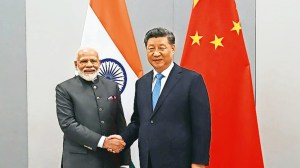For best results, begin at the base
The recent move by the government to extend caste-based reservations to OBCs at central universities...

The recent move by the government to extend caste-based reservations to OBCs at central universities, including institutions like IITs and IIMs, has rekindled the debate on how best to help the weaker sections of society without increasing social divisions and/or imposing major inefficiency costs that the economy can ill-afford in the present age of globalization with its focus on competition and efficiency. Therefore, it is worth considering alternative affirmative action policies that might work better.
The reservation policy has the benefit of achieving some tangible results immediately (which is why it is so appealing to the politicians). But if reservation policies lead to admissions being granted to students from reserved categories with much lower marks than those from the general category they denigrate merit and create a sense of injustice that leads to social divisions and inefficiency. Under the simplistic quota policies being proposed by the government, the benefits are largely cornered by a small creamy layer among the weaker sections, while the children of the truly deserving rarely make it through secondary education and thus receive little benefits from such policies. It is also well known that there is considerable fraud in the administration of the reservation policies with many people resorting to fake certificates.
These problems mean that the benefits of the reservation policy fail to reach the intended beneficiaries. It reflects on our political class as to how little has been done by various governments to resolve these problems or conduct serious studies that examine how the current reservation policies are working and how they can be further streamlined to help the truly deserving.
It is not as if the governments have the power to ignore these issues at their whim. The Supreme Court has already ruled that the creamy layer among the weaker sections should not receive the benefits of reservation. Thus the simplistic quota formula offered by the government is almost certain to be struck down by the courts as unconstitutional (violating basic principles of social justice). Must government after government prove to the people that they are incapable of “applying mind” to important social problems (see the Supreme Court judgement on VP Singh Government’s quota policies)?
A more appropriate set of policies that can truly uplift the weaker sections by raising their educational level is as follows:
(1) Universal school education (with a focus on creating good schooling facilities in areas dominated by SC/ST and OBCs and providing free tuition fees, school books, dresses and mid-day meals (at the school level, these facilities can and should be extended to all children from poor families, irrespective of caste)
(2) Stronger enforcement of affirmative action at more basic levels of higher education, such as vocational training and bachelor’s level college education, to create a base of well trained students from the weaker sections. Then a gradual increase in participation in higher levels of university or professional education MA/PhD, IIMs, IITs and MBBS etc. would gradually come about. Extensive financial assistance provided to all needy students from weaker sections.
These policies should be supplemented with admissions policies that give the weaker sections some “social justice” points to try to increase their participation in the following way (the exact percentages and income levels mentioned below should be taken as indicative that they can be adjusted to some extent):
• Granting an advantage of about 15 percent points to the most underprivileged, i.e. SC/ST with parents’ monthly income below 5,000 and no college education)
• Granting an advantage of about 10 per cent points to the moderately underprivileged, i.e. SC/ST with parents monthly income between Rs 5,000 and 15,000 (and any level of education) and OBCs with parents’ income less than Rs. 5000 per month and no college education)
• Granting about 5 percent points to somewhat underprivileged (OBCs with parents’ income between Rs 5000 to 15,000 monthly and any level of education) and SC/ST with Parents Income between Rs 15,000 and 30,000 per month and any level of education.
The above scheme will ensure that the benefits of affirmative action are shared widely among the weaker sections rather than being cornered by a small creamy layer which is already emancipated and for which for which it was, in fact, never meant. It will also ensure that the inefficiency costs are within reasonable limits. Since the creamy layer can be assumed to have already escaped the hardship of the underprivileged section, total reservations should be accordingly reduced over time (as was originally expected in the Constitution, which had mandated that reservations have to be re-approved by Parliament every 10 years). These policies avoid the pitfalls of simplistic reservation policies and will find much greater acceptance, thus minimizing social divisions and inefficiency costs while ensuring that the truly deserving receive compassion and assistance from the society.
Helping the weaker sections in the above manner is costly but I believe that the policies suggested here will truly uplift the weaker sections in the longer run while avoiding the costs of social divisions and inefficiency which are actually very large, though invisible. Furthermore, by giving financial assistance to our children from weaker sections — many of whom possess tremendous talent that has not received adequate opportunities for education and training for want of financial resources — we will widen the student base from which to select our professionals. This will actually increase their quality and make India more competitive.
Do we have any evidence regarding the use of above recommended policies in any other country? Yes! In fact very similar policies have been practiced in the USA in favour of its black (African) population who have had a history of severe exploitation. The affirmative action programme there requires universal free school education for all. Although blacks form only about 10% of the total population, no strict quotas are ever applied in any admissions or job recruitments. Rather the policy is to search for the best candidates who can reasonably fit the educational programme or job profile by somewhat relaxing the eligibility criteria while ensuring that they will still have the capacity to be reasonably capable of undertaking the educational program or the job for which they are selected. In this way their representation has increased substantially in the professions and jobs without increasing social divisions or imposing high costs of inefficiency on the society.
While a crudely applied reservation policy will increase social divisions and lower professional standards, the policies suggested above can help to uplift the weaker sections without creating social divisions or lowering professional standards. Professor T. Weisskopf, the author of a major book entitled Affirmative Action in USA and India, shows in his study that the USA’s affirmative action policies (similar to those proposed here) have worked better than the reservations policies of India and concludes that pure reservation policies (that do not apply other reasonable ability criteria in admissions) “don’t make any sense”.
Let us hope common sense prevails and politicians learn to apply affirmative action intelligently to build a modern, capable and competitive India, rather than merely playing “divide and rule”.
AFFIRMATIVE ACTION ABROAD
• China: Non-Han ethnic groups (9 per cent of population) exempt from one-child policy; quota for minority representatives in national assembly in Beijing
• European Union: Application of principle of equality without regard to race or ethnic origin; anti-racism directive to be implemented in national law of member states
• Germany: Equal rights for all regardless of sex or race. But also programmes which prefer women for jobs; in 2006, government agreed on draft anti-discrimination law to improve protection of minorities
• Greece: Quotas for women in election processes
• Japan: Varsity, government job recruitment by merit, illegal to include sex, ethnicity in criteria; but informal policy to provide employment and long term welfare to Burakumin at municipality level
• South Africa: Point-based preference for disadvantaged groups in companies under Employment Equity Act; areas covered include equity ownership, representation at employee and management level (up to board of director level), procurement from black-owned businesses and social investment programmes
• Malaysia: Affirmative action providing opportunity for ethnic Malay population; meant to outweigh financial dominance of Malaysian Chinese and Malaysian Indians
• New Zealand: Preferential access to varsities, scholarships for Maoris, Polynesians
• Bosnia-Herzegovina: Women must represent at least 29 per cent of all politicians
• Brazil: Preferred admissions at universities (State or Federal) for racial minorities, the poor and the handicapped; quotas for disabled in civil public services
• Slovakia: affirmative action made illegal in 2005—seen as anti-gipsy decision following Roma hunger riots, which protested curtailing of social aids
(The writer is RBI Chair Professor of Economics, Institute of Economic Growth)
pradeep@iegindia.org
Photos



- 01
- 02
- 03
- 04
- 05



























